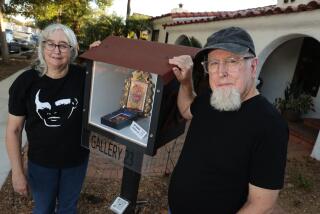San Diego Makes First Purchase of Public Art
- Share via
SAN DIEGO — “Night Vision,” a set of 12 playful sculptures resembling street signs, became the city’s first public art purchase Monday when the City Council voted to pay $11,000 for the brightly colored pieces, which are expected to have a 10-year life span.
Milton Fredman, chairman of the city’s Commission for Arts and Culture, which proposed the purchase, praised the council members, who did not discuss the artworks but approved the purchase “on consent.”
“I think it’s the kind of thing that helps San Diego’s image as a city that’s interested in art,” Fredman said. “It’s important for a city to have pieces of artwork. Like any piece of modern art, it will create controversy, but that’s good.”
Controversy over art has certainly dogged another city agency, the San Diego Unified Port District, which, despite the advice of a blue-ribbon advisory panel, has failed to place even one contemporary artwork on port land in the last four years.
Monday’s council endorsement is particularly sweet for “Night Vision” creator Roberto Salas, who won a Port District regional competition in 1987, only to be turned down last summer by the port commissioners for his proposed blue palm-tree sculpture.
“I’m sure glad (‘Night Vision’) has been purchased,” Salas said Monday. “The thing about it is, it’s been appreciated.”
He said he has continued to work on his blue palm tree concept. “Perhaps it will not be built here, but it will be built elsewhere,” he said.
Salas, who earned a master’s degree from UC San Diego, designed his “Night Vision” series from layered strips of colored vinyl on aluminum sheeting, mounted on aluminum posts. The series remains where it was installed 11 months ago along Park Boulevard near the San Diego Zoo as part of a temporary public art project.
The idea for sign-like sculptures and a street-side location was conceived as part of Salas’ efforts “to locate new exhibition space.”
“My work is about the mobile society, the vehicle, everything the vehicle represents,” Salas said. “This is designed for someone driving along in a vehicle. The vehicle becomes the museum or the gallery.” The reflective vinyl allows drivers to have a passing encounter with the artworks even at night.
The underlying theme of the abstract road signs actually is the traffic cone, Salas said. “The cone is a motif I have been working on for almost 12 years now--its different aspects and forms.”
Salas was a finalist for a 1986 art competition in Los Angeles and won a national competition in 1988 sponsored by Alma College in Alma, Mich. The college installed a sculpture of his, a spiral of books mounted on cables, in the central stairwell of its library last summer.
“Night Vision” was one of eight temporary works contracted by the city’s Public Arts Advisory Board to spruce up the town for the Super Bowl in 1988. Because of delays in finding a site, “Night Vision” did not go up until February, after the Super Bowl. Although the other pieces were removed after the Super Bowl, “Night Vision” had staying power.
“The response was so supportive,” said Joyce Selber, former director of the advisory board and now the culture commission’s public arts administrator. Officials of the city Park and Recreation Department were so impressed that they asked the arts board to consider purchasing the pieces.
Even so, commission members say it was the temporary nature of the work that tended to sway the members of five boards and committees who held hearings and took advisory votes on “Night Vision.”
“I think it is less threatening as a temporary work,” said Karen Cohn, who heads the culture commission’s panel on art in public places. “I think (the various committees) were less inclined to put it up as a permanent piece.” The life span of the series was estimated to be 10 years.
“Night Vision” is the first of four public artworks for San Diego now budgeted by the culture commission. The other pieces are two freeway-oriented gateway projects, an art and landscaping element for Canyonside Community Park and Recreation Center in the Penasquitos Reserve and an environmental artwork called the “Museum of Seasonal Change” in Doyle Park in the University City area.
More to Read
Sign up for Essential California
The most important California stories and recommendations in your inbox every morning.
You may occasionally receive promotional content from the Los Angeles Times.










